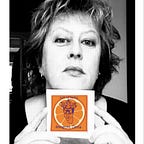Getting Medieval on Love
The history of Valentine’s Day
The lyf so short, the craft so long to lerne…
You know the V-Day drill: hearts, flowers, chocolates. Great if you’re in a relationship, but often not so great if you’re not. Many a lonely soul on Valentine’s Day wonders how did all this insanity get started?
You can blame the Middle Ages for a lot of it. Sure, St. Valentine himself was really a third century Roman martyr, clubbed to death and then beheaded (not a propitious start for the celebrations, eh?). The holiday, however, really only got going when Geoffrey Chaucer set his poem The Parliament of Fowls on that day.
The narrator of the poem, who’s fallen asleep reading Scipio’s book on dreaming, dreams that Scipio leads him through Venus’ temple. Acolytes of the goddess gather there and the walls feature the stories of myriad suffering lovers. The dreamer, who claims to be ignorant of the ways of love apart from what he’s read, observes closely the birds who are gathered outside the temple before the noble goddess Nature herself:
For this was on seynt Valentynes day,
Whan every foul cometh ther to chese his [mate]
In keeping with the hierarchies of medieval life, the birds are all arrayed by rank, each with its kind whether sparrow or duck or robin. They have to take turns, starting at the top. At the center of the gathering are three eagles vying for the hand of the most lovely female eagle who perches on Nature’s own hand. Each of the three tries to prove he is the most worthy suitor. They speak as if they were courtly lovers, another medieval tradition.
“Courtly Love” is where we get a lot of the exaggerated traditions of this holiday like gift giving and extravagant gestures to prove one’s ardour. A satirical work by Andreas Capellanus in the twelfth century The Art of Courtly Love nonetheless proved popular in romances (originally a word that meant “adventures”). The book offers the following rules for lovers, some of which highlight the exaggerated nature of this trend for courtly wooing among the wealthy and mostly idle rich who had time for these elaborate artifices:
1. Marriage is no real excuse for not loving.
2. He who is not jealous cannot love.
3. No one can be bound by a double love.
4. It is well known that love is always increasing or decreasing.
5. That which a lover takes against his will of his beloved has no relish.
6. Boys do not love until they arrive at the age of maturity.
7. When one lover dies, a widowhood of two years is required of the survivor.
8. No one should be deprived of love without the very best of reasons.
9. No one can love unless he is impelled by the persuasion of love.
10. Love is always a stranger in the home of avarice.
11. It is not proper to love any woman whom one should be ashamed to seek to marry.
12. A true lover does not desire to embrace in love anyone except his beloved.
13. When made public love rarely endures.
14. The easy attainment of love makes it of little value; difficulty of attainment makes it prized.
15. Every lover regularly turns pale in the presence of his beloved.
16. When a lover suddenly catches sight of his beloved his heart palpitates.
17. A new love puts to flight an old one.
18. Good character alone makes any man worthy of love.
19. If love diminishes, it quickly fails and rarely revives.
20. A man in love is always apprehensive.
21. Real jealousy always increases the feeling of love.
22. Jealousy, and therefore love, are increased when one suspects his beloved.
23. He whom the thought of love vexes, eats and sleeps very little.
24. Every act of a lover ends with in the thought of his beloved.
25. A true lover considers nothing good except what he thinks will please his beloved.
26. Love can deny nothing to love.
27. A lover can never have enough of the solaces of his beloved.
28. A slight presumption causes a lover to suspect his beloved.
29. A man who is vexed by too much passion usually does not love.
30. A true lover is constantly and without intermission possessed by the thought of his beloved.
31. Nothing forbids one woman being loved by two men or one man by two women.
How many would you agree to? How many seem neurotic? How many remain staples of romantic writing? I always ask my students these questions and I’m surprised how many of the “romantic” notions they still cling to yet. It reminds me I really need to write that book on how medieval our notions of love remain.
Oh, and what happened with the three eagles? They all take so long trying to prove their worth that the other birds get impatient. When Nature asks the flocks to choose the best of the trio, even they can’t agree. Finally, she asks the female eagle to make her choice, but the blushing maiden asks for another year to make up her mind. Nature agrees and the rest of the birds choose their mates in a noisy confusion. The dreamer wakes up, determined to read more about love.
Sometimes that’s easier than braving the wild waters of the real thing!
